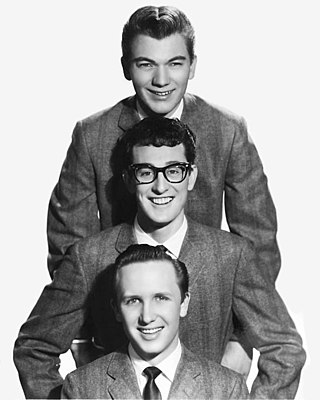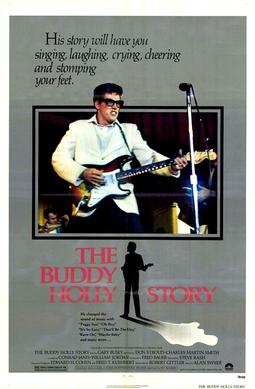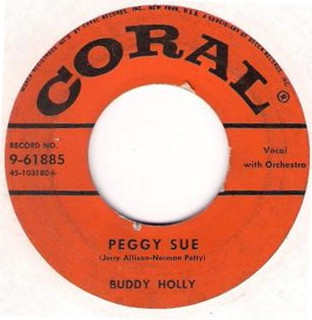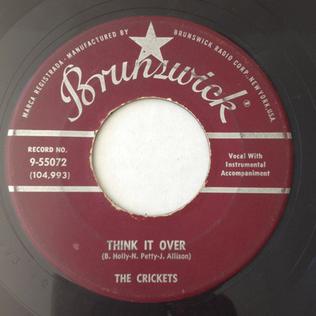
Charles Hardin Holley, known as Buddy Holly, was an American singer, songwriter, and musician who was a central and pioneering figure of mid-1950s rock and roll. He was born to a musical family in Lubbock, Texas, during the Great Depression, and learned to play guitar and sing alongside his two siblings.

The Crickets were an American rock and roll band from Lubbock, Texas, formed by singer-songwriter Buddy Holly in January 1957. Their first hit record, "That'll Be the Day", released in May 1957, peaked at number three on the Billboard Top 100 chart on September 16, 1957. The sleeve of their first album, The "Chirping" Crickets, shows the band line-up at the time: Holly on lead vocals and lead guitar, Niki Sullivan on rhythm guitar, Jerry Allison on drums, and Joe B. Mauldin on bass. The Crickets helped set the template for subsequent rock bands, such as the Beatles, with their guitar-bass-drums line-up, performing their own material. After Holly's death in 1959, the band continued to tour and record into the 1960s and beyond with other band members through to the 21st century.

The Buddy Holly Story is a 1978 American biographical musical drama film directed by Steve Rash which tells the life and career of rock and roll musician Buddy Holly. It features an Academy Award-winning musical score, adapted by Joe Renzetti and Oscar-nominated lead performance by Gary Busey. The film also stars Don Stroud, Charles Martin Smith, Conrad Janis, William Jordan, and Maria Richwine, who plays María Elena Holly.

"That'll Be the Day" is a song written by Buddy Holly and Jerry Allison. It was first recorded by Buddy Holly and the Three Tunes in 1956 and was re-recorded in 1957 by Holly and his new band, the Crickets. The 1957 recording achieved widespread success. Holly's producer, Norman Petty, was credited as a co-writer, although he did not contribute to the composition.
María Elena Holly is the widow of American rock and roll pioneer Buddy Holly. As a receptionist at Peermusic, she met with Holly and his band the Crickets on June 19, 1958, and Holly proposed to her after five hours on their first date. Less than two months later, the couple married on August 15, 1958, in Lubbock, Texas. On February 3, 1959, Buddy Holly died in a plane crash along with fellow musicians Ritchie Valens and The Big Bopper outside Clear Lake, Iowa. After learning of her husband's death from the television news, she suffered a miscarriage the following day and could not attend Holly's funeral in Lubbock.

"Peggy Sue" is a rock and roll song written by Jerry Allison and Norman Petty, and recorded and released as a single by Buddy Holly on September 20, 1957. The Crickets are not mentioned on label of the single, but band members Joe B. Mauldin and Jerry Allison (drums) played on the recording. This recording was also released on Holly's eponymous 1958 album.

Joseph Benson Mauldin, Jr. was an American bassist, songwriter, and audio engineer who was best known as the bassist for the early rock and roll group the Crickets. Mauldin initially played a double (standup) bass, then switched to a Fender Precision Bass guitar. After several years with the Crickets, he became a recording engineer at Gold Star Studios, the Los Angeles studio which became the "hit factory" for Phil Spector, Brian Wilson, and other major 1960s rock performers.
Sonny Curtis is an American singer and songwriter. Known for his collaborations with Buddy Holly, he was a member of the Crickets and continued with the band after Holly's death. Curtis's best known compositions include "Walk Right Back", a major hit in 1961 for the Everly Brothers; "I Fought the Law", notably covered by the Bobby Fuller Four and the Clash; and "Love is All Around", the theme song for The Mary Tyler Moore Show.
Niki Sullivan was an American rock and roll guitarist, born in South Gate, California. He was one of the three original members of Buddy Holly's backing band, the Crickets. Though he lost interest within a few months of his involvement, his guitar playing was an integral part of Holly's early success. He performed on 27 of the 32 songs Holly and The Crickets recorded over his brief career. He co-wrote a number of his own songs. In 2012, Sullivan was inducted into the Rock and Roll Hall of Fame as a member of the Crickets by a special committee, aimed at correcting the mistake of not including the Crickets with Buddy Holly when he was first inducted in 1986.

"Oh, Boy!" is a song written by Sonny West, Bill Tilghman and Norman Petty. The song was included on the album The "Chirping" Crickets and was also released as the A-side of a single, with "Not Fade Away" as the B-side. The song peaked at number 10 on the US charts, number 3 on the UK charts in early 1958, and number 26 in Canada.

"Everyday" is a song written by Buddy Holly and Norman Petty, recorded by Buddy Holly and the Crickets on May 29, 1957, and released on September 20, 1957, as the B-side of "Peggy Sue". The single went to number three on the Billboard Hot 100 chart in 1957. "Everyday" is ranked number 238 on Rolling Stone magazine's list of the "500 Greatest Songs of All Time".

"Peggy Sue Got Married" is a song written and performed by Buddy Holly. It was posthumously released in July 1959 as a 45-rpm single with "Crying, Waiting, Hoping". It refers to his 1957 hit song "Peggy Sue". It was one of the first sequels of the rock era.
Jerry Naylor Jackson was an American country and rock and roll artist, broadcaster and inspirational speaker. From late 1961 through 1964 he was The Crickets' lead vocalist and guitarist.

In Style With the Crickets is a rock and roll album by the Crickets. Although it was the band's first release following the departure and subsequent death of their front man, Buddy Holly, it still contains many of the band's most memorable songs and many tracks have also been featured on numerous compilations over the years. Originally released as an LP record on December 5, 1960, the album remained out of print for some time until it was re-released on CD in 1993, with bonus tracks not featured on the original album.
Harold David Box was an American rock and roll musician in the early 1960s. Box was influenced by fellow Texan Buddy Holly, and even took his place as singer of his group, The Crickets, for a short time after Holly's death. Box also collaborated with Roy Orbison, and found local success with his own group, the Ravens.

"It's So Easy!" is a rock-and-roll song written by Buddy Holly and Norman Petty. It was originally released as a single in 1958 by the Crickets but failed to chart. It was the final release by the Crickets when Holly was still in the band.

"Think It Over" is a rock-and-roll song written by Buddy Holly, Jerry Allison, and Norman Petty in 1958, originally recorded by the Crickets. Vi Petty, Norman Petty's wife, played piano on this recording.

Bobby Vee Meets The Crickets is a cross-over rock and roll album that brings singer Bobby Vee together with the Crickets. It was Vee's 7th album and The Crickets' second release following the departure and subsequent death of their front man, Buddy Holly. The album contains new versions of three songs written by or recorded by Holly—Peggy Sue, Bo Diddley, and Well...All Right—and a host of cover versions of 1950s rock'n'roll songs by artists like Little Richard and Chuck Berry. Originally released as an LP record on July 14, 1962, the album was re-released on CD in 1991, with bonus tracks not featured on the original album.

Something Old, Something New, Something Blue, Somethin' Else is a rock and roll album by the Crickets. It is The Crickets' third release following the departure and subsequent death of their front man, Buddy Holly. As the original cover indicates, the album contains versions of four old songs, four new songs, and four songs with variations of "blue" in the title.

"When You Ask About Love" is a song written by Jerry Allison and Sonny Curtis and recorded by the Crickets in 1959. It was a hit in Britain, reaching number 27 in the UK Singles Chart.













